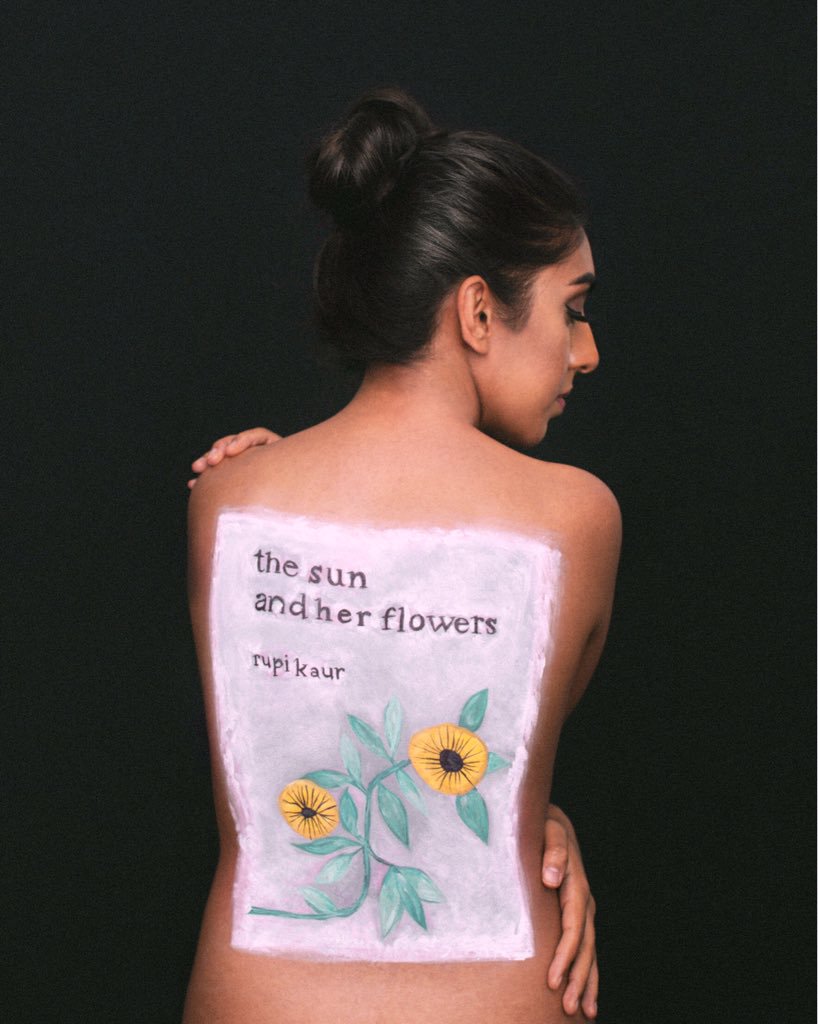
Wilting to Blossom
Cheyenne Davis
The Sun and Her Flowers, written by Rupi Kaur, is a book of poetry compiled of emotional and relational poems dealing with heartbreak, abusive relationships, and healing. Throughout the book, the theme of nature is highly prevalent. The author compares her own body and soul to flowers as a metaphor of growth and new life. The Sun and Her Flowers reflects individuals who have overcome some of the most spiritually crushing barriers or those who continue to seek solace from their pain.
Rupi Kaur initially became famous on the platforms of Instagram and Tumbler for her risky posts supporting feminism. For example, she posted one photo which was used as a way to normalize women’s menstrual cycles. The backlash she received sparked her desire to further support a movement for women’s natural bodies to become less of a taboo. She has since become increasingly popular for her art and poetry that are reflected in both of her books Milk and Honey and The Sun and Her Flowers.
The outward appearance of the book is clothed in sunflowers accompanied by pale colors which make the reader believe that there is going to be cheerful content within. However, the beginning and section pages are dark grey, and the wording is quite melancholy. The portrayal of joy on the outside versus the somber context may represent a longing for happiness despite current inward turmoil. It could also represent the average appearance we as individuals have, but when opened up we are vulnerable, and we each have our own internal battles much like the words on the pages indicate. The structure of the book is organized into 5 themes: wilting, falling, rooting, rising, and blooming. This structure plays on the theme of the flower and the cycle of its life. The theme appeals to those who long to be reminded of what it is like to grow and to feel alive.
“Wilting” is the first section Kaur uses to describe her emotions after a breakup, and she describes the many ways she has been emotionally damaged. Not only this, but Kaur’s poetry in this section demonstrates a desire to rekindle a healthy relationship with her own spiritual being. The emotions that individuals relate to in her poetic works are similar to those of depression, and the experiences of being in verbally and mentally abusive relationships. These toxic relationships are not something that many poets are willing to open up about on the same level as Kaur has been able to do effectively.
“Falling” is the second section where Kaur expresses the depressed emotions associated with heartbreak and loss of self. She explains her feeling of detachment and sadness due to the person she has become which is a result of the hurt she has experienced. Kaur’s vulnerability with the negative emotions she has felt in her life during this “falling” period is one of the factors that her readers adore so much about her style.
“Rooting” is the next section which describes the ways in which Kaur begins to attain her self-worth and also feels the strength to move forward in her life. She is conveying to her readers that despite the tragic events she has been faced with, there is still hope for recovery and living a happy life. “Rising,” the fourth section, is Kaur’s description of the struggles she has faced while making her ascent from a broken place in her life to the person she seeks to become. In this section, she writes about hesitation and a longing for the way things were. Kaur struggles with emotionally detaching from the way things in her life were before she had to experience this monumental loss in her life.
“Blooming” is the final point of the desired outcome. It is the point when the journey has been completed, and the pain is no longer consuming to Kaur. This “blooming” process is nature’s final success before it is turned back to the earth. In this way, it signifies the completion of a long and successful journey for Kaur. This section portrays self-love and true strength, and provides courage to her readers that have experienced a similar struggle.
This book of poems has revolutionized the minds of young women by its empowerment of self and its raw truth in regard to the real pain that is felt at the loss of self and others. Although the book is mainly written from a woman’s perspective, men also have the ability to relate to the emotional suffering caused by toxic relationships and depression. The way Kaur portrays her emotions in her words and her illustrations has the ability to pull at anyone’s heart-strings.